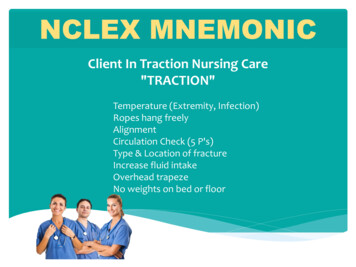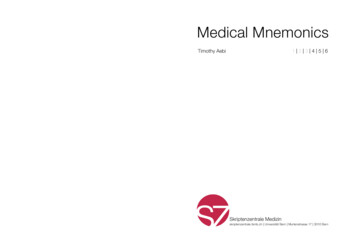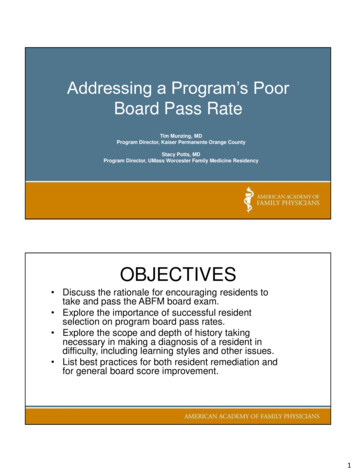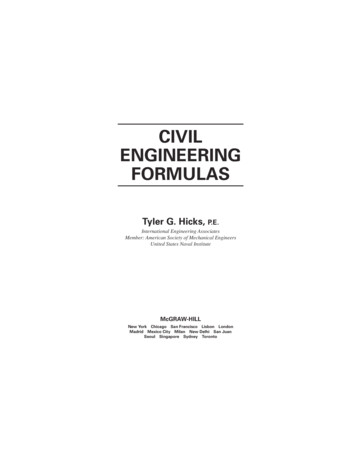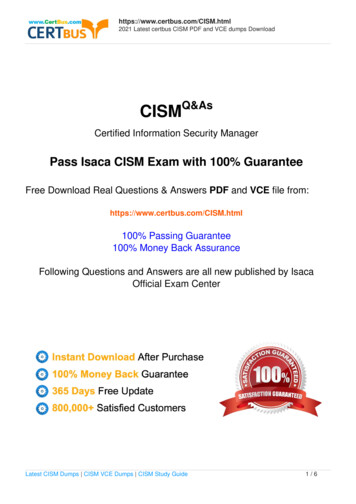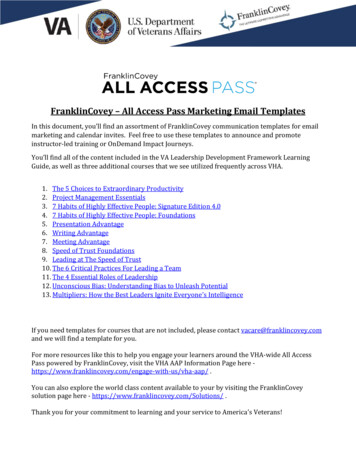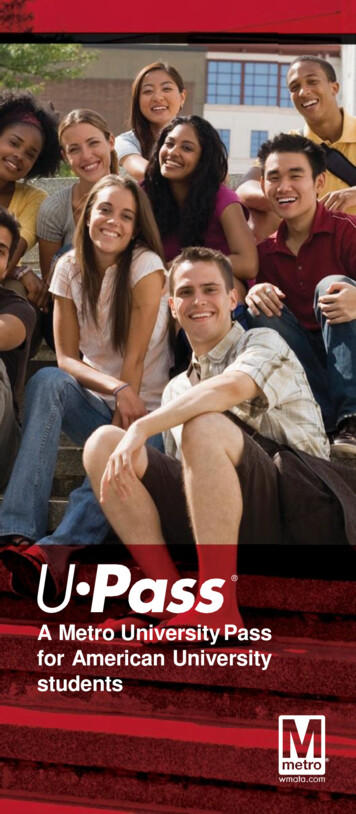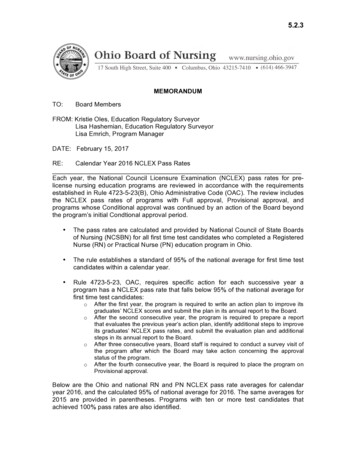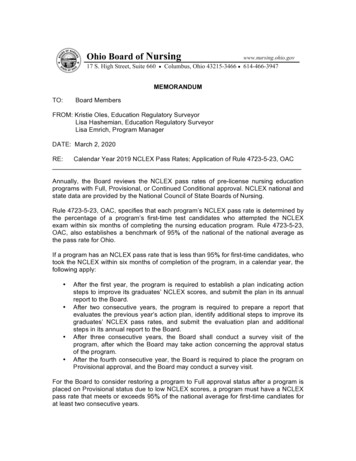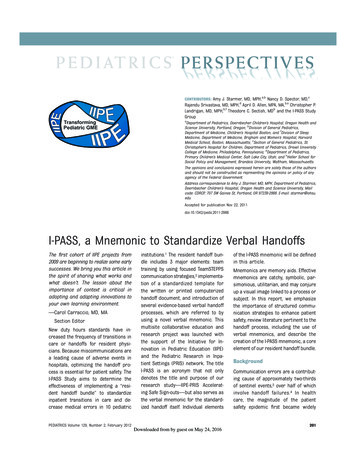
Transcription
CONTRIBUTORS: Amy J. Starmer, MD, MPH,a,b Nancy D. Spector, MD,cRajendu Srivastava, MD, MPH,d April D. Allen, MPA, MA,b,e Christopher P.Landrigan, MD, MPH,b,f Theodore C. Sectish, MDb and the I-PASS StudyGroupaDepartment of Pediatrics, Doernbecher Children’s Hospital, Oregon Health andScience University, Portland, Oregon; bDivision of General Pediatrics,Department of Medicine, Children’s Hospital Boston, and fDivision of SleepMedicine, Department of Medicine, Brigham and Women’s Hospital, HarvardMedical School, Boston, Massachusetts; cSection of General Pediatrics, St.Christopher’s Hospital for Children, Department of Pediatrics, Drexel UniversityCollege of Medicine, Philadelphia, Pennsylvania; dDepartment of Pediatrics,Primary Children’s Medical Center, Salt Lake City, Utah; and eHeller School forSocial Policy and Management, Brandeis University, Waltham, Massachusetts.The opinions and conclusions expressed herein are solely those of the authorsand should not be constructed as representing the opinions or policy of anyagency of the Federal Government.Address correspondence to Amy J. Starmer, MD, MPH, Department of Pediatrics,Doernbecher Children’s Hospital, Oregon Health and Science University, Mailcode: CDRCP, 707 SW Gaines St, Portland, OR 97239-2998. E-mail: starmer@ohsu.eduAccepted for publication Nov 22, 2011doi:10.1542/peds.2011-2966I-PASS, a Mnemonic to Standardize Verbal HandoffsThe first cohort of IIPE projects from2009 are beginning to realize some earlysuccesses. We bring you this article inthe spirit of sharing what works andwhat doesn’t. The lesson about theimportance of context is critical inadopting and adapting innovations toyour own learning environment.—Carol Carraccio, MD, MASection EditorNew duty hours standards have increased the frequency of transitions incare or handoffs for resident physicians. Because miscommunications area leading cause of adverse events inhospitals, optimizing the handoff process is essential for patient safety. TheI-PASS Study aims to determine theeffectiveness of implementing a “resident handoff bundle” to standardizeinpatient transitions in care and decrease medical errors in 10 pediatricinstitutions.1 The resident handoff bundle includes 3 major elements: teamtraining by using focused TeamSTEPPScommunication strategies,2 implementation of a standardized template forthe written or printed computerizedhandoff document, and introduction ofseveral evidence-based verbal handoffprocesses, which are referred to byusing a novel verbal mnemonic. Thismultisite collaborative education andresearch project was launched withthe support of the Initiative for Innovation in Pediatric Education (IIPE)and the Pediatric Research in Inpatient Settings (PRIS) network. The titleI-PASS is an acronym that not onlydenotes the title and purpose of ourresearch study—IIPE-PRIS Accelerating Safe Sign-outs—but also serves asthe verbal mnemonic for the standardized handoff itself. Individual elementsPEDIATRICS Volume 129, Number 2, February 2012of the I-PASS mnemonic will be definedin this article.Mnemonics are memory aids. Effectivemnemonics are catchy, symbolic, parsimonious, utilitarian, and may conjureup a visual image linked to a process orsubject. In this report, we emphasizethe importance of structured communication strategies to enhance patientsafety, review literature pertinent to thehandoff process, including the use ofverbal mnemonics, and describe thecreation of the I-PASS mnemonic, a coreelement of our resident handoff bundle.BackgroundCommunication errors are a contributing cause of approximately two-thirdsof sentinel events,3 over half of whichinvolve handoff failures.4 In healthcare, the magnitude of the patientsafety epidemic first became widely201Downloaded from by guest on May 24, 2016
recognized with the publication of ToErr Is Human in 1999, which concludedthat medical errors cause up to 98 000preventable deaths annually in theUnited States.5 Subsequently, calls foraction emerged from the federal government and many private and professional organizations, including therecommendation that principles fromHigh Reliability Organizations (HROs)be applied to the health care system.HROs are organizations in high-risk,high-impact industries that consistently achieve high quality outcomesdespite experiencing many unexpectedevents where the potential for error isvery high.6 These organizations employ team training and reliability science to improve their performance,the roots of which arose from themilitary and civilian aviation communities. Programs such as Crew Resource Management have led to majoradvances in team training and mayresult in dramatic improvements infatalities, accident related costs, andhuman factor based mishaps.A specific application of HRO principlesis the use of explicit verbal mnemonicsto standardize communication. One ofthe most commonly used communicationtools, SBAR, an acronym for “situation,background, assessment, recommendation,” was developed by Doug Bonacum,vice president of Kaiser Permanente andformer safety officer on a nuclear submarine.7 During a patient safetyworkgroup meeting, Bonacum described expectations when handing offa situation to an officer on deck. Thesekey concepts were translated into coreelements of the SBAR mnemonic. Success of a pilot study investigating theuse of SBAR as a communication toolled to rapid spread across hospitalsnationwide and studies examining itseffectiveness.8 Implementation of SBARin 1 hospital was associated with substantial drops in the rates of adverseevents (from 90 to 40 per 1000 patient202days) and adverse drug events (from30 to 18 per 1000 patient days).9SBAR was developed to facilitate theefficient transmission of information. Itis most effective when time is limitedand a quick decision is needed, as thistool is suited to situations when a briefsummary is sufficient and fewer than5 key points need to be communicated.Further, this mnemonic should be usedas a situational briefing tool, as intended,and is appropriate for use across hierarchical boundaries.10 Although useof SBAR has been extended to handoffsof patient care at change of shift orpatient location, there are limitationsin its applicability, particularly in situations that include transmission of information about complex patients whorequire broader information and context.Development of the I-PASSMnemonicGiven the limitations of SBAR, alternative mnemonics have been developed,implemented, and tested for use inhandoffs of care. A recent systematicreview of published handoff mnemonics identified 46 articles describing24 different handoff mnemonics.11 Mosthave not been rigorously studied, however, and descriptions of their derivation are lacking. A notable exceptionincludes an article describing the useof the SIGNOUT mnemonic, which wasshown to increase the consistency andconfidence with which residents performverbal sign-outs, as compared with animplicit, informally structured process.12Drawing from the apparent evidencebased success of the SIGNOUT mnemonic, we included the SIGNOUT mnemonicin a pilot resident handoff bundleintervention study at the Children’sHospital Boston that preceded theongoing multicenter I-PASS study.Resident input was a key factor in thisselection. Efforts were made to reinforce use of the mnemonic during the postintervention study period,STARMER et alDownloaded from by guest on May 24, 2016including regular faculty and chief resident observations and feedback regarding the verbal handoff process.However, we found that a majority ofverbal handoffs did not adhere to thestructure of the SIGNOUT mnemonic.As part of the process for curriculumdevelopment for the I-PASS study, wereflected on the successes and challenges of SIGNOUT, and considered useof the mnemonic, IPASSTHEBATON fromTeamSTEPPS.13 Feedback from chiefresidents who had been involved in thepilot curriculum, however, expressedthe need for a mnemonic that wasshorter, easier to remember, and haddiscrete elements without overlap.They felt strongly that elements of themnemonic needed to be fully integratedinto computerized handoff tools.Modeling the process used to designthe original SBAR mnemonic, we (DrsStarmer, Spector, Landrigan, and Sectish) conducted a brainstorming sessionand identified the essential elements ofa verbal handoff. We focused on elements that pilot study faculty observersnoted were most commonly absentfrom resident handoffs (illness severityassessment, contingency planning, andread-back by the receiving resident)and incorporated best practices forverbal handoffs from our review ofexisting literature.The results of this session led to thedevelopment of a novel mnemonic, I-PASS(Fig 1), which serves as the cornerstonefor the resident handoff bundle thatis currently being implemented andtested in the I-PASS study.The I-PASS mnemonic provides a framework for the patient handoff process asfollows:I: Illness severityP: Patient summaryA: Action listS: Situation awareness and contingency planningS: Synthesis by receiver
PEDIATRICS PERSPECTIVESConclusionsFIGURE 1The novel mnemonic, I-PASS, was developed from best handoff practicescited in the literature, resident feedback from a pilot study, and observations made by faculty of the handoffprocess. Structured communication,especially at the time of transitions incare, is essential to promote patientsafety. The multisite I-PASS study willtest the effectiveness of the residenthandoff bundle, including the I-PASSmnemonic, on medical errors in 10pediatric institutions. Lessons learnedmay apply to other settings where theopportunities to improve the handoffprocess remain a challenge.Elements of the I-PASS mnemonic.An example of a verbal I-PASS handoffcommunication is provided in Fig 2.As we began implementing the I-PASSmnemonic, we received widespread interest in it from other providers in ourstudy institutions, including physiciansfrom other specialties and nurses. Webelieve that it can readily be adapted foruse beyond pediatrics. Specifically, thepatient summary element is easily adapted to include specific information elements that are key for each provider type.ACKNOWLEDGMENTSThis project was supported with a grantfrom the US Department of Health andHuman Services, Office of the AssistantSecretary for Planning and Evaluation,grant 1R18AE000023-01. AdditionallyDrs Landrigan and Srivastava are supported in part by the Child Health Corporation of America for their work onthe PRIS Research Network ExecutiveCouncil. Dr Starmer is supported in partby an institutional K12 award fromOregon Health and Science Universityand the Agency for Health Care Researchand Quality, grant 1K12HS019456-01.Developed with input from the IIPEand the PRIS Network.IIPE is the Initiative for Innovation in Pediatric Education and is the entity thatrecognizes innovative educational proposals for pediatric residency trainingprograms. More can be found on theWeb site, www.innovatepedsgme.org.PRIS is a collaborative hospitalist research network sponsored by theAmerican Academy of Pediatrics, the Academic Pediatric Association, the Society of Hospital Medicine, and the ChildHealth Corporation of America. Detailsare available at http://www.prisnetwork.org.Members of the I-PASS Study Group include coinvestigators from the following institutions as follows: Children’sHospital Boston (primary site): AprilD. Allen, MPA, MA, Angela Feraco, MD,Christopher P. Landrigan, MD, MPH,Theodore C. Sectish, MD; Brigham andWomen’s Hospital (data coordinatingcenter): Carol Keohane, RN, Stuart Lipsitz, PhD, Jeffrey Rothschild, MD, MPH;Cincinnati Children’s Hospital MedicalCenter: Javier Gonzalez del Rey, MD,Med, Jennifer O’Toole, MD, Lauren Solan,FIGURE 2Example of a verbal handoff by using the I-PASS mnemonic.PEDIATRICS Volume 129, Number 2, February 2012203Downloaded from by guest on May 24, 2016
MD; Doernbecher Children’s Hospital/Oregon Health and Science University:Megan Aylor, MD, Gregory Blaschke,MD, MPH, Cynthia L. Ferrell, MD, MSEd,Benjamin D. Hoffman, MD, Amy J.Starmer, MD, MPH, Windy Stevenson,MD, Tamara Wagner, MD; Hospital forSick Children/University of Toronto: ZiaBismilla, MD, Maitreya Coffey, MD, SanjayMahant, MD, MSc, Anne Matlow, MD;Lucile Packard Children’s Hospital/Stanford University: Lauren Destino,MD, Jennifer Everhart, MD, MadelynKahana, MD, Shilpa J. Patel, MD; National Capital Consortium: JenniferHepps, MD, Joseph O. Lopreiato, MD,MPH, Clifton E. Yu, MD; Primary Children’sMedical Center/Intermountain HealthCare: James F. Bale, Jr., MD, RajenduSrivastava, MD, MPH, Adam Stevenson, MD; St. Louis Children’s Hospital/Washington University: KathleenBerchelmann, MD, F. Sessions Cole, MD,Christine Hrach, MD, Kyle S. Schulz, MD,Michael Turmelle, MD, Andrew White,MD; St. Christopher’s Hospital for Children: Sharon Calaman, MD, Bronwyn D.Carlson, MD, Matthew B. McDonald III,MD, Robert S. McGregor, MD, VahidehNilforoshan, MD, Nancy D. Spector,MD; and University of California, SanFrancisco, Benioff Children’s Hospital:Glenn Rosenbluth, MD, Daniel C. West,MD. Dorene Balmer, PhD, RD and AlanSchwartz, PhD, serve the I-PASS StudyGroup as part of the IIPE ResearchSupport Team. Karen M. Wilson, MD,MPH, serves the I-PASS Study Groupas part of the PRIS advisory board.REFERENCES1. Sectish TC, Starmer AJ, Landrigan CP,Spector ND; I-PASS Study Group. Establishing a multisite education and researchproject requires leadership, expertise,collaboration, and an important aim.Pediatrics. 2010;126(4):619–6222. US Department of Health and HumanServices, Agency for Healthcare Researchand Quality. TeamSTEPPS home page.Available at: http://teamstepps.ahrq.gov/.Accessed September 29, 20113. The Joint Commission. Sentinel event statistics data: root causes by event type.Available at: www.jointcommission.org/Sentinel Event Statistics/. Accessed September 27, 20114. The Joint Commission. Improving handoff communications: meeting nationalpatient safety goal 2E. Joint CommissionPerspectives on Patient Safet
tive mnemonics have been developed, implemented, and tested for use in handoffs of care. A recent systematic review of published handoff mnemon-ics identified 46 articles describing 24differenthandoffmnemonics.11 Most have not been rigorously studied, how-ever, and descriptions of their deriva-tion are lacking. A notable exception includes an article describing the use of the
